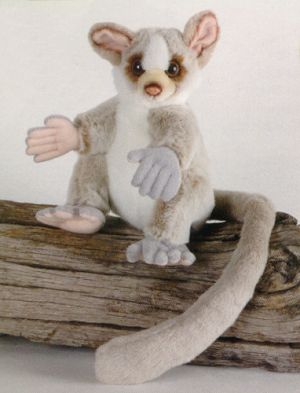|
|
The incredible Stuffed Plush Galago or Bush Baby Monkeys
that are featured here have some of the
most Alluring and Cute Eyes and poses you will ever
find in a stuffed animal or stuffed monkey.
These plush stuffed Galago Monkeys
are without a doubt - absolutely Adorable
a certain keepsake you will Cherish forever!

So Soft & Cuddly plush stuffed Galago Monkey
of the finest quality.
Stuffed plush Galago Monkey
select the Stuffed Ark banner Here:

Tons more stuffed monkeys at our stuffed ark site
The Galago or Bush Baby Monkey
The Galagos are native to the continent of Africa. They are
small nocturnal primates that make up the Galagidae family,
also known as Galagonidae. They are also sometimes
considered a part of the Loridae or Lorisidae subfamily in
scientific classification.
The Galagos go by many names and are sometimes called
bushbabies, bush babies or Nagapies (which means "little
night monkeys" in Afrikaans) because they are only seen at
night. It is suggested that they gained the nickname of bush
baby because they look like babies or their cry sounds like
a baby.
The Galagos can run quickly across branches and leap agiley
from branch to branch and tree to tree, and hop across the
ground. They have dense, wooly fur, mobile, hairless ears
with acute hearing, long tails for balance, strong back legs
and excellent night vision with their over-large dark eyes.
Bush Babies have fleshy pads on the ends of their long,
slender fingers and toes, and nails on the end of every
digit except for the second two of the back legs. This
instead has a long "toilet" claw that is used for grooming.
They also have special comb-like teeth that are used for
grooming themselves and each other.
They eat fruits, tree gum, insects and other small animals.
This provides a lot of variety in the diet and when one
source of food isn't as abundant the Galagos troop can
easily switch to another source. For instance, when fruit is
no longer in season the animals can rely primarily on tree
gum, insects and small animals.
A Galago is pregnant for one hundred ten to one hundred
thirty-three days. The offspring is completely dependent on
the mother for the first few weeks as when it is born it
can't move about on its own. The eyes are half closed when
the offspring is born. After the first week when the mother
is feeding she sets the baby down on a branch and otherwise
she carries it around in her mouth.
The social groups mainly consist of groups of females and
their daughters and offspring. When a male Galagos reaches
puberty it will leave it's mother's territory but the
daughters stay. The females maintain the territory.
The males establish their own territories that overlap the
female territories. In general, one male mates with all
females in the area. Sometimes when males haven't
established a territory that overlaps a female group's
territory they will form loose bachelor groups.
Galegos communicate with each other as they travel by
calling to each other and by marking their paths through the
trees with urine. In the evening they do a special call to
gather the troop for the night. The nest is made of branches
and leaves or in the hole of a tree.
Although some people keep Bushbabies as pets, it is not
recommended because zoonotic disease can easily be
transfered from Galagos to a human and vice versa. They are
also ill suited to life with humans because they are
nocturnal and have complicated needs. Bushbabies have been
reported to have lifespans of twelve to sixteen years in
captivity.
The scientific classification of the Galagidae has recently
discovered some new species within the family Galagidae.
They are now grouped into three different genera. Members of
the now defunct genus Galagoides have returned to the
original genus Galago.
Primates:
Suborder Strepsirrhini: non-tarsier prosimians
- Family Cheirogaleidae: dwarf and mouse lemurs
- Family Lemuridae: lemurs
- Family Lepilemuridae: sportive lemurs
- Family Indriidae: wooly lemurs and allies
- Family Daubentoniidae: Aye-aye
- Family Lorisidae: lorises, pottos and allies
- Family Galagidae: galagos, or bushbabies
- Genus Otolemur : greater galagos, or thick-tailed bushbabies
- Genus Euoticus : needle-clawed bushbabies
- Genus Galago : lesser galagos, or lesser bushbabies
Suborder Haplorrhini: tarsiers, monkeys and apes
|